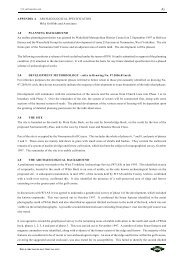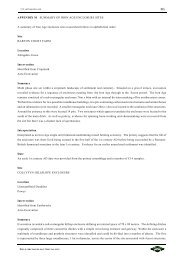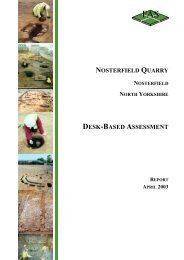ARCHAEOLOGICAL EVALUATION - Mike Griffiths and Associates
ARCHAEOLOGICAL EVALUATION - Mike Griffiths and Associates
ARCHAEOLOGICAL EVALUATION - Mike Griffiths and Associates
Create successful ePaper yourself
Turn your PDF publications into a flip-book with our unique Google optimized e-Paper software.
FAS_lbf01.wpd 14<br />
Heritage, at the Thornborough monument complex itself. Sections of the outer <strong>and</strong> inner ditch of the southern<br />
henge were investigated in 1995 <strong>and</strong> 1997 respectively (Harding <strong>and</strong> Johnson 2003, 19); the inner ditch<br />
produced a radiocarbon date of 1695 to 1540 BC (Harding et al 1999), which is considered to be unreliable<br />
(Harding <strong>and</strong> Johnson 2003, 19). In 1998, excavation was undertaken at the central henge, where a 20m by 20m<br />
trench was excavated <strong>and</strong> again used to identify successive phases of monument development. A pit alignment<br />
within the Scheduled Ancient Monument area was largely excavated. The feature was explored using<br />
geophysical survey in 1995 <strong>and</strong> in 1998-9 was subject to archaeological excavation, when 82 of the 88 pits were<br />
investigated (Harding <strong>and</strong> Johnson 2003, 23). This work revealed evidence for post voids <strong>and</strong> packing stones<br />
indicative of timber uprights.<br />
During August <strong>and</strong> September 2003, a further programme of reconnaissance fieldwalking was carried out in the<br />
surrounding area, covering l<strong>and</strong> to the north of the central henge, as well as a large area east <strong>and</strong> north of<br />
Ladybridge Farm. Total lithic collection was also undertaken in August <strong>and</strong> September 2003 (Harding 2003,<br />
16; Harding <strong>and</strong> Johnson 2004c). This was carried out in four locations which had previously produced flint<br />
artefacts during fieldwalking, <strong>and</strong> produced an assemblage of flint artefacts of Mesolithic to Bronze Age date,<br />
which allowed for identification of changing use of the l<strong>and</strong>scape over time. Following this, forty-two test pits<br />
were excavated, revealing a number of field boundaries <strong>and</strong> linear features.<br />
Geophysical survey of five known round barrows in the vicinity of the henge monuments was undertaken in July<br />
2003, two of which were then subject to excavation (Harding <strong>and</strong> Johnson 2004d). Redeposited cremated bone<br />
was identified in soil which had been badly disturbed by ploughing (Harding 2004d, 10). Excavation of a<br />
double ditched barrow identified during geophysical survey revealed a number of pits containing skeletal<br />
remains (Harding 2004d, 16).<br />
2.9.2 Fieldwork at Nosterfield Quarry<br />
Prior to, <strong>and</strong> during research in the surrounding area, a programme of watching briefs, further evaluation <strong>and</strong><br />
survey was carried out on the site of Nosterfield Quarry, to the west of Ladybridge Farm. This work began in<br />
1991, with a desk-based assessment of the general area, which was followed by a programme of evaluation<br />
trenches in areas to the south <strong>and</strong> west of the Ladybridge Farm buildings, undertaken in support of the planning<br />
application for the current quarry operation (Dall<strong>and</strong> 1995; FAS 2005a: Investigation 2).<br />
Following the commencement of gravel extraction at Nosterfield Quarry, watching briefs were carried out as<br />
each phase progressed, with the agreement of the County Archaeologist. In an area to the north of the<br />
Nosterfield road, <strong>and</strong> south of Ladybridge Farm, the watching brief encountered the remains of a number of pits<br />
<strong>and</strong> scoops which produced lithics <strong>and</strong> pottery of Neolithic date (FAS 2005: Investigation 3). Subsequently,<br />
an area to the west of pre-existing quarry workings at Nosterfield was subject to further watching brief,<br />
revealing evidence for further pits of likely prehistoric date (FAS 2005: Investigation 4). A watching brief over<br />
a small area to the east of this, carried out by the West Yorkshire Archaeology Service, revealed no further<br />
features (FAS 2005: Investigation 5), <strong>and</strong> a gradiometry survey over an area immediately to the north of the road<br />
revealed few features of archaeological significance (FAS 2005: Investigation 6). The lack of features which<br />
could be identified by these methods was highlighted by a watching brief in the same area, which revealed<br />
evidence for a pit alignment (FAS 2005: Investigation 7). However, a further watching brief to the west of this<br />
FIELD ARCHAEOLOGY SPECIALISTS







